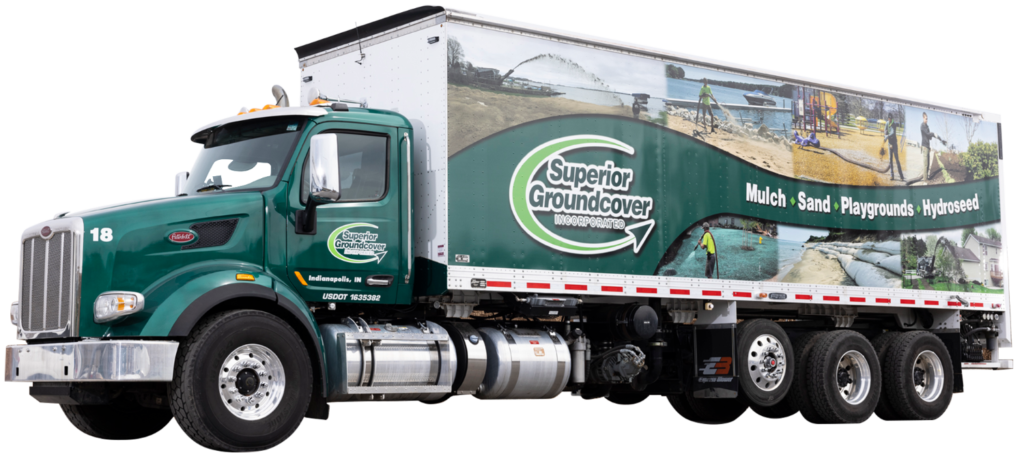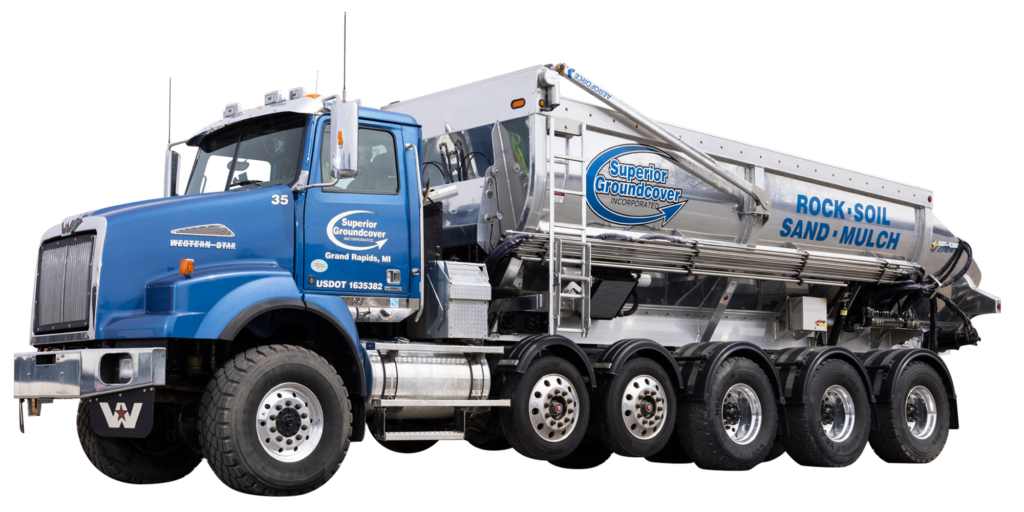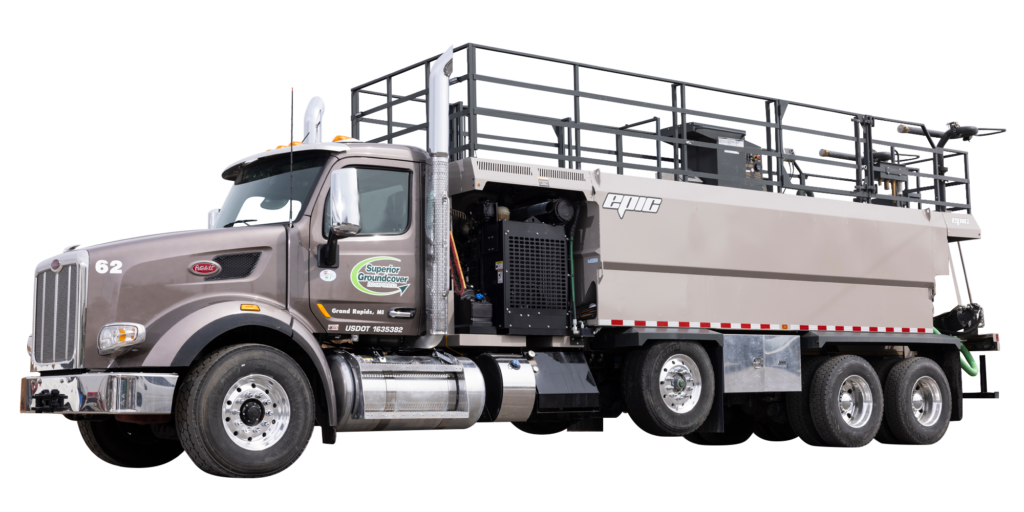How do construction sites cause erosion?
“Soil erosion is defined as the wearing away of land by the action of wind, water, or gravity or a combination of wind, water, and gravity. The result of this wearing away of land is that soil particles are dislodged and put into motion. Soil particles that are in transport or have been transported to new locations and deposited are called sediment. The sedimentation of Michigan’s water resources can adversely affect plant, animal and aquatic life by altering the size or shape of streams or covering the spawning habitat of aquatic species.” — https://www.michigan.gov/documents/dtmb/SESC_Guidebook_2019_660638_7.pdf
Construction involves a lot of earth movement, both intentional and unintentional. This movement often leads to erosion, which can impact both the site and the natural areas around it. Earth movement is not the only cause of construction site erosion. Changing the land levels through grading leads to wind and water erosion as well. All of these changes can be harmful to the environment, ruining soil quality, causing water pollution, and impacting both plants and animals. It’s the contractor’s responsibility to limit erosion through responsible practices.
Soil erosion happens when construction equipment begins to kill vegetation. Vegetation provides root systems, which hold dirt in place and prevent erosion. When builders grade the site, dirt can be displaced by both wind and water erosion.
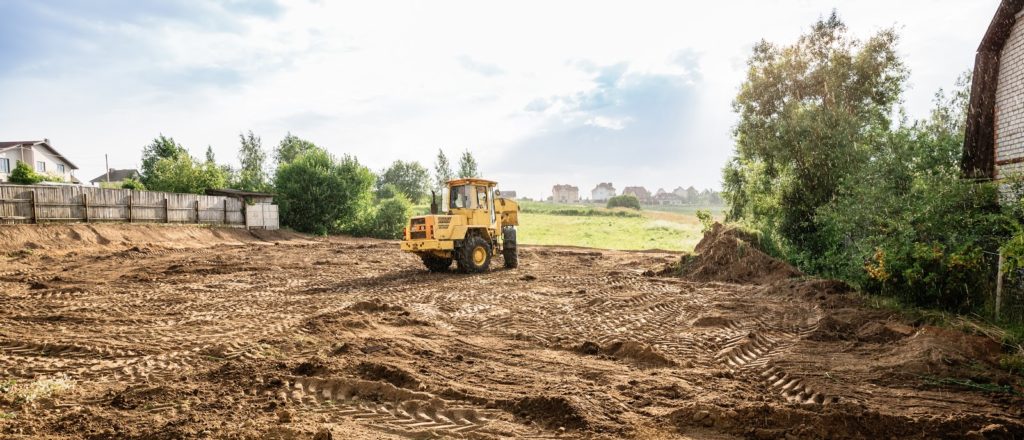

There are five main types of erosion:
- Rain erosion
- Sheet erosion
- Rill erosion
- Gully erosion
- Streambank erosion
What are the effects of erosion from construction sites?
Even though construction erosion only impacts the surrounding areas, its effects can be extremely detrimental. Activities like filling and grading reduce soil quality, lead to erosion, and environmental degradation.
Some of the dangers of erosion from construction sites include:
-
Reduced soil quality
“The loss of topsoil, either by actual removal with heavy equipment or erosion by wind and water, is the worst on-site damage in urban areas. This layer of soil has the highest biological activity, organic matter, and plant nutrients— all key components of healthy soil. The on- site loss of this upper layer of soil nearly eliminates the soil’s natural ability to provide nutrients, regulate water flow, and combat pests and disease.” — USDA.gov
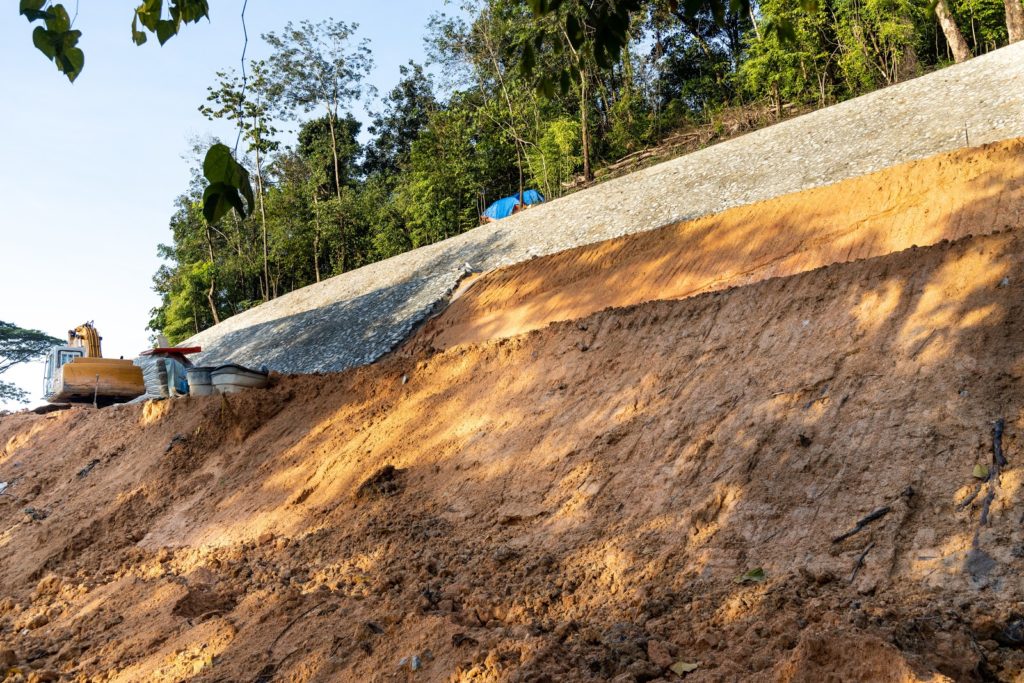

-
Water pollution
Erosion caused by construction has impacts off-site as well. Erosion leads to two main water pollution issues: extra sediment and extra nutrients, which damage the ecosystems in the water.
Too many nutrients? Too many nutrients in the water can, in fact, cause a lot of damage. This is because they cause something called “Eutrophication.” Eutrophication is the process in which extra nitrogen and phosphorus leads to overgrowth.
Extra sediment in the water makes it cloudy — which is called “Turbidity.” Turbidity is damaging because it blocks sunlight from entering the water. This, in turn, leads to a reduction of photosynthesis and damages vegetation growth. Lessened photosynthesis causes a reduction of oxygen levels, which impacts the habitat for the fish and other plants and animals.
How can I plan for erosion before starting construction?
You can plan for the types of erosion that may occur, and therefore need to be prevented based on the features of the site and surrounding areas.
“The amount and the type of vegetative cover determine the amount of soil erosion taking place at a particular site. The vegetation absorbs the energy of the falling rain and slows down the velocity of the runoff thereby reducing its capacity to carry sediments. The grass or vegetative cover also acts a filter to catch sediments and helps maintain the absorptive capacity of the soil. The roots of the plants hold the soil in place and prevent it from being carried off as sediments with the runoff.” — Purdue.edu
Other prevention methods include:
- Construction phasing is a helpful way to reduce erosion. Construction phasing is when the land is cleared intentionally, one area at a time as the project continues. In contrast to clearing the whole site, phasing prevents larger areas from being bare and exposed to erosion. This is more costly at first, but saves money down the road because soil will not need to be replaced and less management will need to be done to control the related erosion.
- Another tactic to reduce erosion is to make sure to schedule excavations when there is minimal rainfall and excavate efficiently so as not to leave soil exposed for a prolonged period
- Keep any disturbed soil covered with vegetation or mulch to reduce displacement.
- Limit your use of heavy equipment to reduce soil compaction.
Since erosion is inevitable and not entirely preventable, other actions must be taken to lessen the impact on the environment. Sediment control methods help remove soil from runoff and reduce overall pollution.
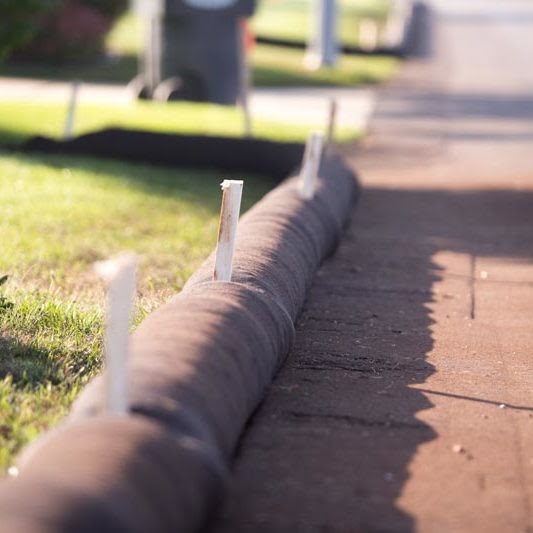

Sediment control methods include:
- Sediment Ponds.
Sediment ponds are a highly effective sediment control method. The method involved slowing down the speed of water flow so that instead of being carried, sediment falls to the bottom of the ponds. - Gravel Entrance.

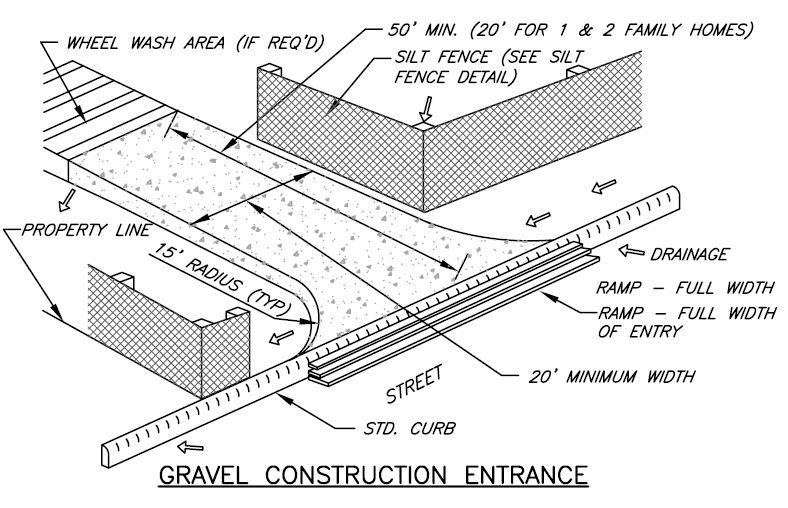
Gravel entrances are stabilized entrances to construction sites which help keep soil on the site and prevent it from being dragged off site. Gravel entrances must be large enough for construction equipment and at least 6 inches deep.
- Silt Fences.
Silt Fences are very prevalent, however, they aren’t the most effective sediment control method. In order for silt fences to work, they have to be placed at the bottom of a slope. If the slope is steeper or longer, the fence has to be placed further from the bottom of the slope. Silt fences must also be monitored for sediment build up. If sediment build up has reached half of the height of the fence, it has to be removed. Make sure that the geotextile fabric is buried deep enough so that water does not run below it.
Each area requires different types of erosion and sedimentation control plans for construction projects.
Resources for Michigan can be found here: https://www.michigan.gov/dtmb/0,5552,7-358-82550_60101-155023–,00.html
“The Department of Technology, Management & Budget (DTMB) has established Soil Erosion and Sedimentation Control (SESC) procedures to provide effective soil erosion and sediment control, inspection and enforcement on State of Michigan construction projects. These procedures are provided in detail in the DTMB Soil Erosion and Sedimentation Control Guidebook.”— michigan.gov
How can I prevent erosion on a construction site?
In order to prevent erosion on construction sites, you need to know 6 basic principles of erosion.
- Reduce & Resist! Reduce the erosive forces like water & wind. Resist erosion by using erosion control methods.
- Sediment Control. If you can prevent sediment erosion, it’s much less expensive than cleaning up the mess later.
- Change the Topography. Certain slopes are less likely to erode, or erode much more slowly. Shorter slopes are better because they allow for better vegetation establishment.
- Keep your soil safe! Wind and water cause soil erosion. Protecting soil from the elements will prevent erosion. Keep any vegetation and keep water away.
- Slow it down! Fast-moving runoff will cause faster erosion. By changing slopes and using techniques like dams and drains, you can slow down waterflow.
- Keep an eye on things. Monitor your erosion control methods to make sure they are still effective.
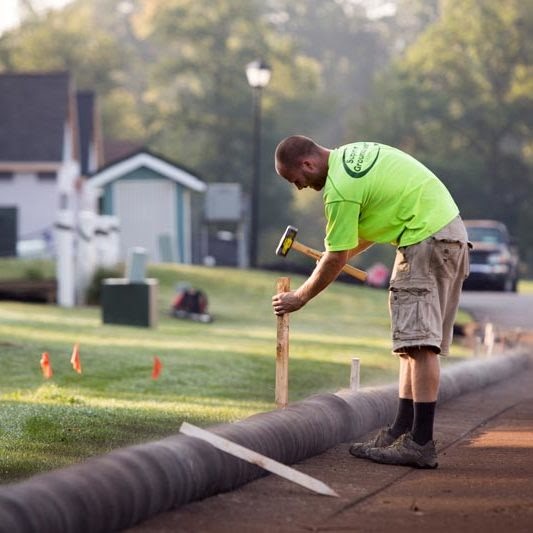

What are common construction mistakes that worsen erosion?
The first mistake is overlooking soil.
“Soil is important but is often an overlooked component of our urban infrastructure. It is especially important in regulating runoff of storm water and in supporting trees, shrubs, lawns, and gardens. Soil erosion during construction is often a serious problem. Many erosion control practices are available in local soil and water conservation district offices. However, the effects of erosion on construction sites continue to menace society both from on-site and off-site damages.” — USDA.gov
Erosion prevention should be part of your construction plan, as it’s the best and easiest way to control erosion. Correcting erosion issues after the fact is much more costly and difficult.
One major mistake that can cause erosion is placing a sediment fence across a drainage line. This is a very common mistake. When a sediment fence is placed across a drainage line, the drain can’t do its job. These types of dams should only be used to control water flow. Dams help slow the water flow so that the drain has a series of pools down the slope instead of fast flowing water, which can erode the soil.
When this mistake is made, storms can become disastrous. Storms can cause scouring, or even drain failure — worsening erosion.
Another mistake that can cause construction site erosion is not diverting up-slope water away from the site. Extra water on the site can increase erosion, or overflow the on-site drainage system.
Failing to create a solid drainage system creates a muddy site and excessive erosion.
What are the best methods of erosion control on construction sites?
Some ways that you can control erosion on a construction site are through the use of barriers like earth walls, soil nails, riprap, turbidity barriers, and concrete blocks. Drainage is also very important to control erosion on a construction site.
Vegetation Establishment — Superior’s Compost Erosion Control Blanket combines nutrient-rich compost mixed with high-quality seed to create the perfect environment for quick vegetation establishment and slope stabilization.
Filter Soxx — Superior Groundcover uses 100% organic materials for all erosion control and Terraseeding® applications. Filtrexx® compost filter socks are used for sediment control, slope protection, stream bank and shoreline stabilization, and vegetated retaining walls. Tired of trenching in silt fence? Try our filter socks on for size!
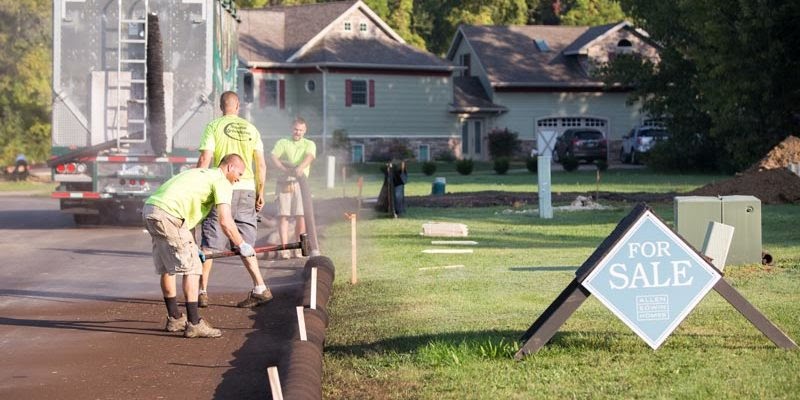

Earth Walls — Earth walls are made of concrete and then filled with soil. They can be used on slopes to prevent erosion.
Soil Nails — Soil nails are inserted into the sides of hills in order to reinforce the slope.
RipRap — RipRap is large stones that form a wall. RipRap is used to block runoff and prevent water erosion.
Turbidity Barriers — Turbidity barriers rely on geotextile membranes to hold soil back from entering the water. They float on the surface of the water and are anchored with weights.
Concrete Blocks — Concrete blocks that fit together can follow the shape of the land and hold soil in place. They are effective near water.Drainage Solutions like french drains help carry water away from the construction site to prevent water erosion
Resources:
https://engineering.purdue.edu/mapserve/LTHIA7/lthianew/impact/erosion.htm

